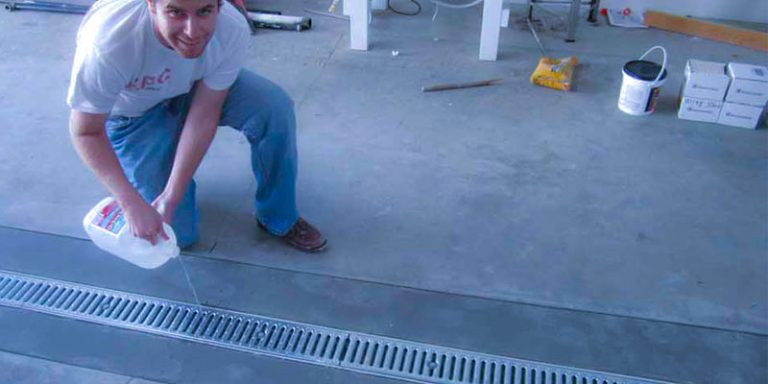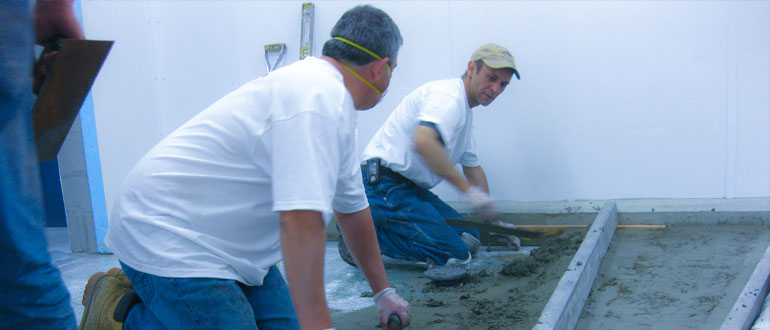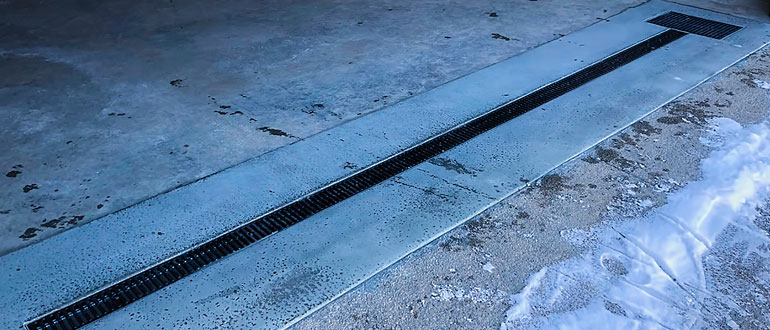Installing a floor drain in a concrete slab can be daunting. But it is essential for ensuring proper drainage and preventing water damage to your property. Whether you’re looking to install a floor drain in a concrete slab, garage, or other areas prone to water accumulation, taking the necessary steps to ensure a successful installation is essential.
In this guide, we will walk you through the steps of installing a floor drain in a concrete slab, including the tools and materials needed and tips for ensuring a durable and leak-free installation. Additionally, With the proper preparation and attention to detail, you can install a floor drain that will provide reliable drainage and peace of mind for years to come. So, let’s get started!
Gather the Necessary Tools and Supplies
Sure! Here’s a list of tools and supplies you’ll need to install a floor drain in a concrete slab:
- Floor drain: This is the main component of your installation. Be sure to choose a drain that is the right size and type for your specific application.
- Concrete saw: You will need a concrete saw to cut the hole for the drain in the concrete slab. You can rent a saw from a home improvement store or hire a professional to do the cutting for you.
- Hammer and chisel: You’ll need these tools to remove any remaining concrete around the perimeter of the hole after cutting it with the saw.
- Trowel: A trowel will be useful for smoothing out any rough edges or bumps in the concrete around the drain hole.
- Drainage pipe and fittings: You’ll need to connect the drain to a drainage system using PVC pipes and fittings. Make sure you choose the right size and type of pipes and fittings for your specific installation.
- Gravel: You’ll need a layer of gravel to create a stable base for the drain. Make sure the gravel is clean and free of debris.
- Concrete mix: You’ll need to mix and pour new concrete around the drain to secure it in place.
- Measuring tape: You’ll need a measuring tape to ensure the drain is positioned correctly in the concrete slab.
- Level: You’ll need a level to ensure the drain is installed correctly and doesn’t cause water to pool.
- Safety gear: Don’t forget to wear safety gear such as eye protection, gloves, and a dust mask while working with concrete and power tools.
By gathering these tools and supplies, you’ll be well-equipped to install a floor drain in a concrete slab.
Prepare the Area to Install a Floor Drain in a Concrete Slab
Here are the steps to prepare the area for installing a floor drain in a concrete slab:
- Determine the location: First, decide where you want to install the floor drain. Make sure it’s in an area where water tends to collect, such as a basement or garage.
- Mark the area: Use a measuring tape to mark the outline of the drain on the concrete slab. Use a chalk line to create a straight line around the perimeter of the drain.
- Remove excess concrete: Use a hammer and chisel to remove any remaining concrete around the perimeter of the hole. Make sure to create a smooth surface for the new concrete to be poured.
- Add gravel: Pour a layer of clean gravel into the hole to create a stable base for the drain. Make sure the gravel is evenly distributed and level.
- Install the drain: Place the floor drain into the hole on top of the gravel. Make sure it is level and flush with the surrounding concrete.
- Connect the drain: Connect the drainage pipe and fittings to the bottom of the drain. Make sure to follow the manufacturer’s instructions and use the right size and type of pipes and fittings.
- Pour new concrete: Mix and pour new concrete around the drain to secure it in place. Use a trowel to smooth out the surface and create a clean finish.
- Allow to dry: Allow the concrete to dry completely before testing the drain to ensure it’s working properly.
The Best Ways and Methods
Installing a floor drain in a concrete slab requires careful planning and execution to ensure a durable and leak-free installation. Here are some best ways and methods to install a floor drain in a concrete slab:
- Choose the right location: As mentioned earlier, it’s essential to choose the right location for the floor drain. It should be installed in an area where water tends to collect, such as a basement, garage, or laundry room.
- Determine the drain size: Make sure to choose the right size drain for your specific application. The size will depend on the expected flow rate and the size of the drainage pipe.
- Ensure proper slope: The concrete slab around the drain should slope toward the drain to ensure proper drainage. Typically, a slope of 1/4 inch per foot is recommended.
- Use the right materials: Use high-quality materials such as PVC pipes, fittings, and a durable floor drain to ensure longevity and minimize the risk of leaks.
- Create a stable base: Use clean gravel to create a stable base for the drain. This will help to prevent settling and ensure proper drainage.
- Connect the drainage pipe: Connect the drainage pipe to the bottom of the drain and make sure it’s properly sealed to prevent leaks.
- Pour new concrete: Pour new concrete around the drain and make sure to use a trowel to smooth out the surface and create a clean finish.
- Test the drain: Once the concrete has dried, test the drain to ensure it’s working properly. Pour water into the drain and observe whether it’s draining properly without any leaks.
Diy Guide to Installing a Floor Drain in a Concrete Slab with Efficiently
Here’s a DIY guide to installing a floor drain in a concrete slab with efficiency:
- Gather all the required tools and supplies before starting the installation.
- Choose the location for the floor drain carefully, ensuring it is in a suitable location for drainage and easy access.
- Use a concrete saw or jackhammer to cut through the slab at the marked location, being mindful of any existing plumbing or electrical systems.
- Dig a hole for the drain that is 2-3 inches deeper than the thickness of the drain flange, using a shovel or excavator for efficient digging.
- Add a layer of clean gravel to the bottom of the hole for stability and efficient drainage.
- Connect the PVC pipes and fittings to the drain with suitable solvent cement before placing the drain into the hole.
- Check the level of the drain using a spirit level before filling in the hole with high-strength concrete mix.
- Smooth the surface of the concrete with a trowel for efficient water flow.
- Wait for the concrete to cure for the recommended time before testing the drain for proper drainage and sealing.
By following these steps efficiently, you can successfully install a floor drain in a concrete slab, ensuring durability and longevity. It is important to take safety precautions, and if you are unsure of any aspect of the installation, seek professional help.
Common Issues to Install a Floor Drain in a Concrete Slab
Installing a floor drain in a concrete slab can be a challenging task, and there are some common issues that you may encounter during the process. Here are some of the most common issues you may face when installing a floor drain in a concrete slab:
- Incorrect slope: If the slope of the concrete slab is not adequate, it can lead to improper drainage and standing water around the drain. This can cause water damage, mold growth, and other related problems.
- Poor connection to drainage pipes: If the connection between the floor drain and the drainage pipes is not properly sealed, it can cause leaks and water damage. Make sure to use high-quality PVC pipes, fittings, and a durable floor drain to minimize the risk of leaks.
- Improper installation of the drain: If the floor drain is not installed correctly, it can lead to issues such as leaks, odors, and blockages. Make sure to follow the manufacturer’s instructions and ensure that the drain is level and flush with the surrounding concrete.
- Inadequate preparation: If the area around the drain is not properly prepared, it can lead to issues such as uneven concrete, an unstable base, and poor drainage. Make sure to clean the area thoroughly, remove any excess concrete, and add a layer of clean gravel to create a stable base for the drain.
- Insufficient ventilation: If the drain is not properly ventilated, it can cause unpleasant odors and blockages. Make sure to install proper ventilation to ensure proper airflow and prevent odor buildup.
By being aware of these common issues and taking the necessary precautions, you can minimize the risk of problems and ensure a successful installation of a floor drain in a concrete slab.
The Most Common FAQs
Here are some frequently asked questions (FAQs) regarding the installation of a floor drain in a concrete slab:
Can a floor drain be installed in an existing concrete slab?
A: Yes, it is possible to install a floor drain in an existing concrete slab, but it can be a more challenging task than installing one in a new slab. You will need to cut through the concrete and create a suitable hole for the drain, which can be time-consuming and labor-intensive.
How deep should the hole for the drain be?
A: The depth of the hole will depend on the type of drain and the drainage pipe used. Typically, a hole that is 2-3 inches deeper than the thickness of the drain flange is recommended.
Do I need to use a specific type of concrete mix for the area around the drain?
A: Yes, it’s recommended to use a high-strength concrete mix for the area around the drain to ensure durability and minimize the risk of cracking or settling.
A: Can I install a floor drain myself, or do I need to hire a professional?
While it is possible to install a floor drain yourself, it is a complex and labor-intensive task that requires a certain level of expertise. You should hire a professional to ensure a proper installation and minimize the risk of issues such as leaks or improper drainage.
How often should I clean and maintain my floor drain?
A: You must clean and maintain your floor drain regularly to prevent blockages and maintain proper drainage. Depending on the amount of usage and the type of debris that flows through the drain, you may need to clean it every few months or as often as weekly.
By understanding these common questions and concerns. You can make informed decisions when it comes to installing a floor drain in a concrete slab.
Conclusion
In conclusion, Installing a floor drain in a concrete slab can be a complex task. That requires careful planning, preparation, and execution. However, it is possible to install a floor drain with the right tools, materials, and knowledge. That is durable, reliable, and effective.
Furthermore, ensuring the concrete slab is properly prepared is crucial to a successful installation. The drain is installed correctly, and the surrounding area must seal and appropriately ventilated. By taking the time to address these issues, You can minimize the risk of common problems such as leaks, improper drainage, and odors.
Overall, Installing a floor drain in a concrete slab can provide numerous benefits. Including improved drainage, reduced risk of water damage, and increased hygiene and safety. By following the steps outlined in this guide, you can enjoy these benefits and ensure a successful installation.
You May Also Like to Read:




